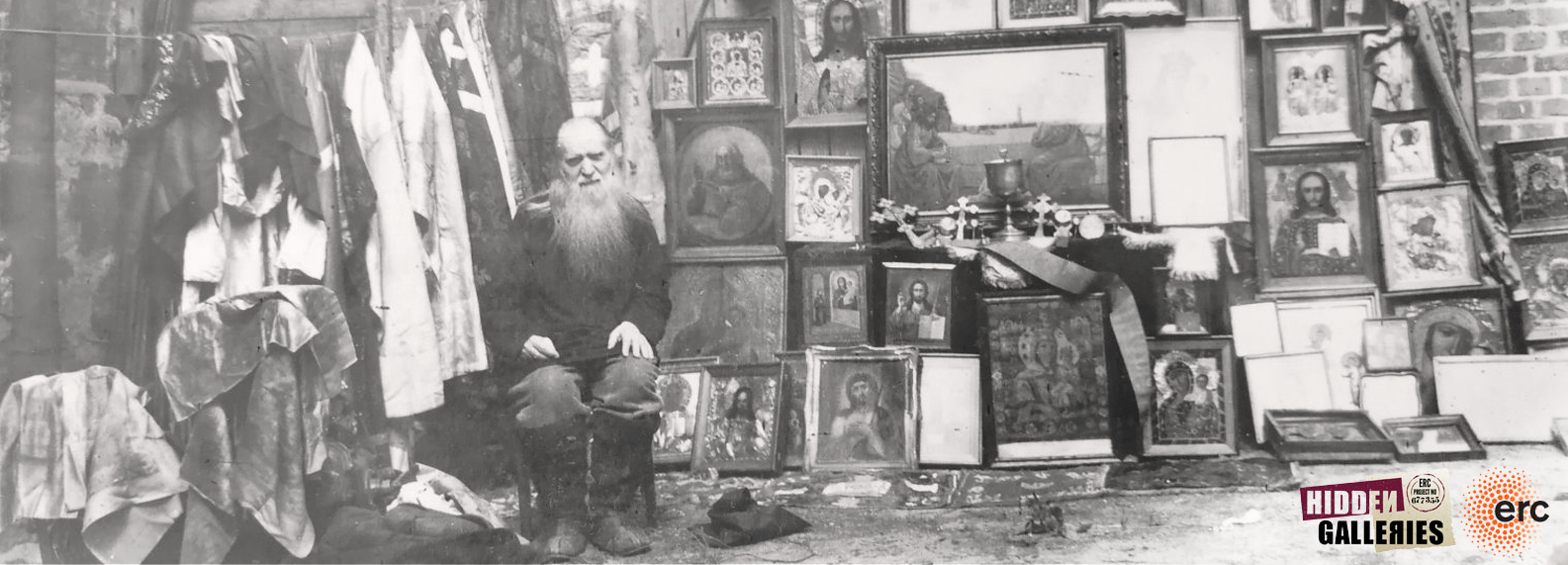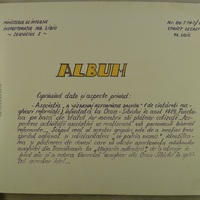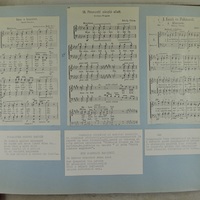Secret police photo album on a Hungarian Calvinist Church Choir Romania
Item
Title
Secret police photo album on a Hungarian Calvinist Church Choir Romania
Egy romániai magyar református templomi kórus titkosrendőrségi foltóalbuma 1973-ból
Description
These images come from a photo album compiled by the Securitate on the Hungarian Calvinist Church Choir in the town of Ocna Sibiului (Vízakna), Transylvania. The first image shows the title page of the album with a short introduction to the choir and its supposed activity. In the second image, we can see photos which were most probably taken by the secret police displaying the decorated walls of the choir’s meeting place. The third image includes shots taken in the usual fashion of crime scene photographs of items confiscated from the choir during a secret police raid. The fourth image shows close-ups of confiscated musical scores with Hungarian themes, the national anthem of Hungary amongst them.
In 1973, the choir was accused of nurturing nationalist-irredentist ideals behind the façade of their church choir and of being hostile to the socialist Romanian state. The album, which itself is a documentary file containing photos of confiscated documents and images owned by the group or taken by the secret police, was carefully designed to support this claim. It starts with a five and a half page report on the history and activity of the choir stating that the choir’s real aim was to maintain the national identity of the local Hungarian minority and to instil Hungarianess in the next generation. The reporting officer made efforts to portray the choir as a conspiratory group not independent of other equally dubious Hungarian organisations. He claimed that it had negative influence on the discipline of the local community. The album then continues with group photographs of choir members, exterior and interior photos of the group’s meeting room focusing on its Hungarian patriotic decoration, crime scene photos of confiscated materials, selected operative documentation of the choir (minutes of meetings, financial reports, membership lists etc.), its correspondence with past members or other organisations, musical scores and finally, several pages taken from confiscated notebooks written by the choir's former secretary, an elderly man who was an amateur local historian and an avid preserver of memories of the local Hungarian past. The photos are often amended with explanatory captions that give translations of the documents or point to the nationalistic nature of the choir; for example, under the 1971 group photo the officer writes: “the colour of the (previously Hungarian national) flag is now black, the symbol of mourning, and the Hungarian tricolour is carried secretly in the hearts of the members.”
From the report we know that after the raid some leading members were interrogated by the secret police and were kept under surveillance afterwards. The choir was allowed to continue with its church related duties but local party leaders were ordered to “pay more attention to the proper education of local Hungarians.”
Ethnographic fieldwork revealed that the Securitate’s attack on the choir is still part of the community’s memory and oral history. As several members recalled, the operation on the choir had been drawn up by an ethnic Hungarian officer who befriended the choir’s former secretary. Playing on his Hungarian roots he claimed to be interested in Hungarian historical matters and cajoled the old man to loan his historical writings to him. A couple of days later the Securitate launched a raid on the choir’s meeting place and confiscated most of its documentation and its official stamp. These items, as well as the notebooks taken from the ex-secretary were never returned. Loss of these materials meant the loss of a large part of the choir’s past. Fieldwork with surviving members of the choir has revealed that the community had made efforts to compensate for this loss: some of the notebooks had been rewritten or recreated since.
Accusing religious groups with ethnic minority backgrounds of being nationalist or irredentist was common in socialist Romania. As this case shows it was not always religion or religious practice that the authorities were after but the supposed political affiliations of these groups.
The Ocna Sibiului Calvinist Church Choir was founded in 1889. From 1907 it officially operated as an association with a president, secretary, accountant and had its own banner and stamp. Its main task was to sing at the funerals of congregation members and at church services, but was also central to community life for local Hungarians. The choir still functions today.
The images come from file CNSAS D 015847.
For related entries see:
In 1973, the choir was accused of nurturing nationalist-irredentist ideals behind the façade of their church choir and of being hostile to the socialist Romanian state. The album, which itself is a documentary file containing photos of confiscated documents and images owned by the group or taken by the secret police, was carefully designed to support this claim. It starts with a five and a half page report on the history and activity of the choir stating that the choir’s real aim was to maintain the national identity of the local Hungarian minority and to instil Hungarianess in the next generation. The reporting officer made efforts to portray the choir as a conspiratory group not independent of other equally dubious Hungarian organisations. He claimed that it had negative influence on the discipline of the local community. The album then continues with group photographs of choir members, exterior and interior photos of the group’s meeting room focusing on its Hungarian patriotic decoration, crime scene photos of confiscated materials, selected operative documentation of the choir (minutes of meetings, financial reports, membership lists etc.), its correspondence with past members or other organisations, musical scores and finally, several pages taken from confiscated notebooks written by the choir's former secretary, an elderly man who was an amateur local historian and an avid preserver of memories of the local Hungarian past. The photos are often amended with explanatory captions that give translations of the documents or point to the nationalistic nature of the choir; for example, under the 1971 group photo the officer writes: “the colour of the (previously Hungarian national) flag is now black, the symbol of mourning, and the Hungarian tricolour is carried secretly in the hearts of the members.”
From the report we know that after the raid some leading members were interrogated by the secret police and were kept under surveillance afterwards. The choir was allowed to continue with its church related duties but local party leaders were ordered to “pay more attention to the proper education of local Hungarians.”
Ethnographic fieldwork revealed that the Securitate’s attack on the choir is still part of the community’s memory and oral history. As several members recalled, the operation on the choir had been drawn up by an ethnic Hungarian officer who befriended the choir’s former secretary. Playing on his Hungarian roots he claimed to be interested in Hungarian historical matters and cajoled the old man to loan his historical writings to him. A couple of days later the Securitate launched a raid on the choir’s meeting place and confiscated most of its documentation and its official stamp. These items, as well as the notebooks taken from the ex-secretary were never returned. Loss of these materials meant the loss of a large part of the choir’s past. Fieldwork with surviving members of the choir has revealed that the community had made efforts to compensate for this loss: some of the notebooks had been rewritten or recreated since.
Accusing religious groups with ethnic minority backgrounds of being nationalist or irredentist was common in socialist Romania. As this case shows it was not always religion or religious practice that the authorities were after but the supposed political affiliations of these groups.
The Ocna Sibiului Calvinist Church Choir was founded in 1889. From 1907 it officially operated as an association with a president, secretary, accountant and had its own banner and stamp. Its main task was to sing at the funerals of congregation members and at church services, but was also central to community life for local Hungarians. The choir still functions today.
The images come from file CNSAS D 015847.
For related entries see:
E képek az erdélyi Vízaknai Református Dalkörről készített titkosrendőrségi fotóalbumból valók. Az első fotó az album címlapját ábrázolja, amely rövid összefoglalót ad a kórus feltételezett tevékenységéről. A másodikon szereplő képeket minden valószínűség szerint a Szekuritáte munkatársai készítették a kórus tanácstermének dekorációjáról. A harmadik képen bűnügyi helyszínelő fotókat láthatunk a titkosrendőrség által a kórustól egy házkutatás során elkobzott anyagokról, a negyediken pedig magyar témájú dalok, például a magyar nemzeti himnusz kottájáról készült nagyításokat.
A kórust 1973-ban a titkosrendőrség azzal vádolta meg, hogy egyházi feladatai mögé bújva nacionalista-irredenta nézeteket ápol és ellenséges érzelmeket táplál a szocialista román állammal szemben. A lefoglalt dokumentumokról készült képeket, illetve a kórustagok tulajdonából származó vagy a titkosrendőrség által készített fotókat tartalamzó albumot, amely tulajdonképpen egy titkosszolgálati dosszié, célzottan úgy állították össze, hogy a fenti vádakat bizonyítsa. A dokumentum elején olvasható, öt és fél oldalas tanulmány beszámol a kórus múltjáról és tevékenységéről, hangsúlyozva azt, hogy a csoport valódi célja a magyar nemzeti identitás megőrzése és továbbadása a következő generációknak. Az albumot összeállító tiszt igyekezett a kórust több magyar szervezettel is kapcsolatban álló konspiratív csoportosulásként beállítani, amely káros befolyással van a vízaknai magyar közösségre. Az album ezután a kórustagokról készült csoportképekkel, a kórus tanácstermének hazafias magyar tematikájúként értelmezett dekorációjáról készült felvételekkel, az elkobzott anyagokat ábrázoló helyszíni fotókkal, a kórus válogatott dokumentációjával (jegyzőkönyvek, pénzügyi jelentések, taglisták stb.), valamint az egykori tagokkal, illetve más szervezetekkel folytatott levelezésével és kottákkal folytatódik. A dosszié utolsó lapjain a kórus korábbi titkárának jegyzetfüzeteiből kinagyított oldalak láthatók, aki amatőr történészként igyekezett a település magyar vonatkozású emlékeit megőrizni. A képekhez az album készítője magyarázatokat fűzött, amelyekben a kórus nacionalista beállítódását hangsúlyozta. Az 1971-ben készült csoportkép alá például a következő sorokat írta: „A (korábbi magyar nemzeti) zászló színe most fekete, a gyász színe, a magyar trikolórt a tagok titokban a szívükben hordják.”
Az albumban olvasható jelentés szerint a házkutatás után a kórus elöljáróit a titkosrendőrség kihallgatta és folyamatosan megfigyelés alatt tartotta. A kórus az egyházi feladatait továbbra is elláthatta, ám a helyi pártvezetőket utasították arra, „hogy fordítsanak nagyobb figyelmet a helyi magyarok megfelelő nevelésére”. A közösség tagjai körében végzett antropológiai terepmunka során kiderült, hogy a kórus titkosrendőrség általi meghurcolása ma is fontos eleme a helyi magyar közösség emlékezetének. A tagok elmesélték, hogy a kórus elleni akció egy magyar származású szekuritáte tiszt műve volt, aki kihasználva származását összebarátkozott a kórus volt titkárával, és arra hivatkozva, hogy nagyon érdekli a helyi közösség történelme, kölcsönkérte tőle történeti feljegyzéseit. Néhány nap múlva a Szekuritáte házkutatást tartott a kórus tanácstermében, ahonnan elvitték a kórus iratait és hivatalos pecsétjét. Az ekkor elvitt tárgyak sosem kerültek vissza a kórushoz, ahogyan az idős titkár feljegyzései sem. Elvesztésük érzékeny veszteség volt a csoport számára, amely ezzel lényegében a múltját vesztette el. A terepmunka során kiderült, hogy közösség megpróbálta e hiányt valamennyire pótolni, például a kórus jegyzőkönyveinek újraírásával.
Az, hogy a kisebbségi hátterű vallási csoportokat nacionalizmussal vagy irredentizmussal vádolják, nem volt ritka a szocialista Romániában. A kórus esete azt mutatja, hogy a hatóságok sok esetben nem a vallásosságuk vagy vallásgyakorlatuk, hanem sokkal inkább feltételezett politikai nézeteik vagy kapcsolataik miatt léptek fel egy-egy vallási csoporttal szemben.
A Vízaknai Református Dalkört 1889-ben alapították a vízaknai református gyülekezet tagjai. 1907-ben egyesületté alakult, amelynek elnöke, titkára, könyvizsgálója, saját zászlója és pecsétje is volt. Bár elsődlegesen temetési és templomi kórusként működött, fontos szerepet játszott a helyi magyar közösség kulturális életében is. A kórus a mai napig aktív.
Forrás: CNSAS D 015847
Kapcsolódó bejegyzések:
Subject
Communism and Christianity--Europe, Eastern
Communism--Europe--History--20th century
Communism--Europe, Eastern--History--20th century
Secret police (secret service)
Surveillance
Totalitarianism
Religion and politics--Europe
Religion and state--Europe
Religious groups
Communism--Romania
Communism--Romania--History
Communism--Romania--History--20th century
Confiscations
Evidence photographs
Nationalism--Romania--History
Romania. Securitatea
Nationalism and communism
Creator
Agnes Hesz
Source
Consiliul Național pentru Studierea Arhivelor Securității
CNSAS D 015847
CNSAS D 015847
Publisher
This project has received funding from the European Research Council (ERC) under the European Union’s Horizon 2020 research and innovation programme No . 677355
Date
1973
Rights
copyright for these images belongs to CNSAS
Format
jpg
Language
ro
hu
hu
Type
image
Identifier
CNSAS D 015847
Coverage
20th century
Romania, Transylvania
Romania, Transylvania
Bibliographic Citation
Agnes Hesz, "Secret police photo album on a Hungarian Calvinist Church Choir Romania,"
Date Created
2018




